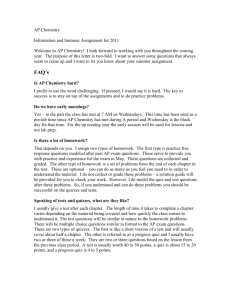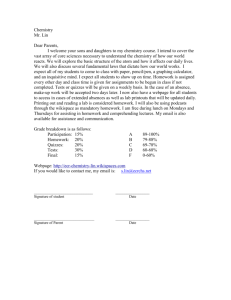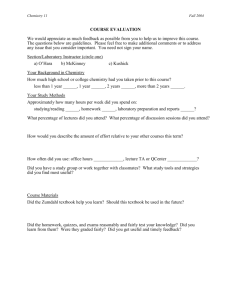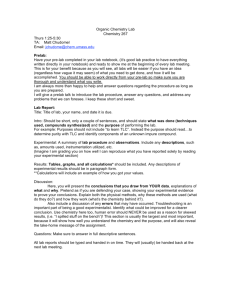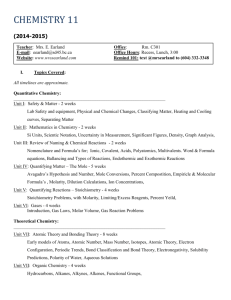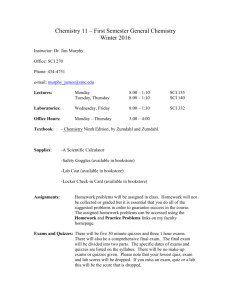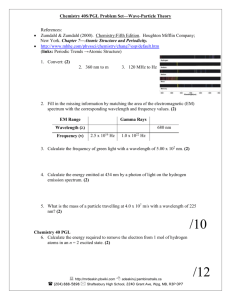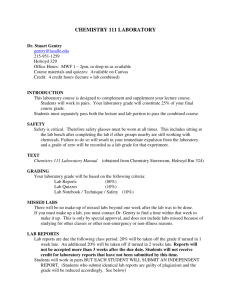Mr. Morrow's AP Chemistry Course Syllabus 2014-2015
advertisement
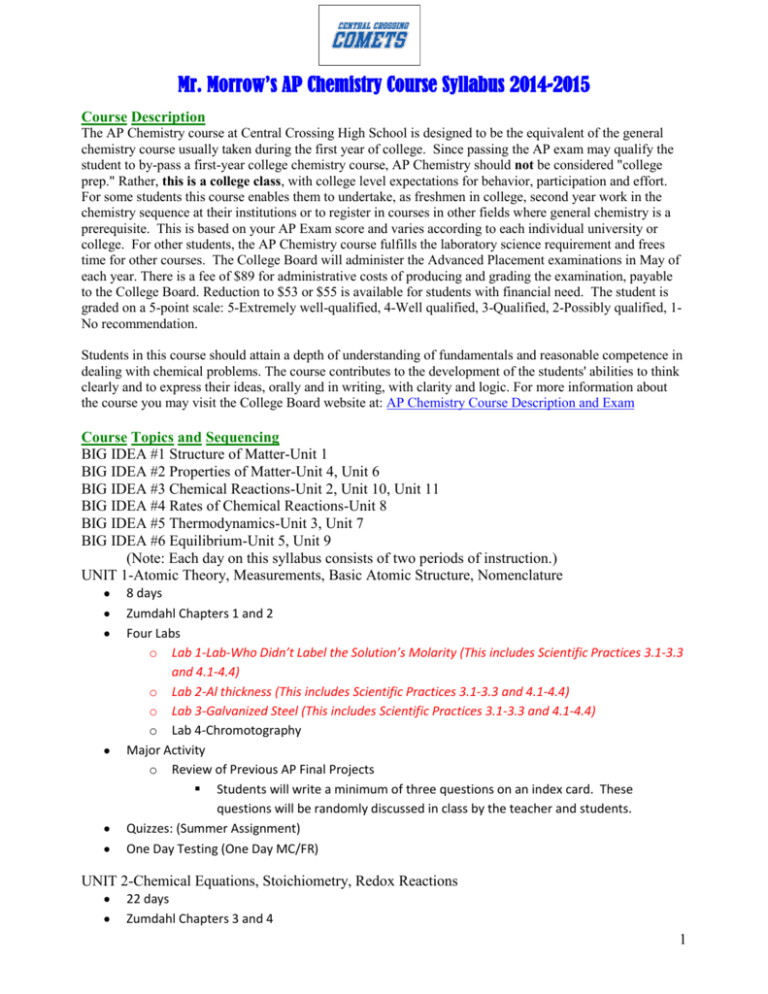
Mr. Morrow’s AP Chemistry Course Syllabus 2014-2015 Course Description The AP Chemistry course at Central Crossing High School is designed to be the equivalent of the general chemistry course usually taken during the first year of college. Since passing the AP exam may qualify the student to by-pass a first-year college chemistry course, AP Chemistry should not be considered "college prep." Rather, this is a college class, with college level expectations for behavior, participation and effort. For some students this course enables them to undertake, as freshmen in college, second year work in the chemistry sequence at their institutions or to register in courses in other fields where general chemistry is a prerequisite. This is based on your AP Exam score and varies according to each individual university or college. For other students, the AP Chemistry course fulfills the laboratory science requirement and frees time for other courses. The College Board will administer the Advanced Placement examinations in May of each year. There is a fee of $89 for administrative costs of producing and grading the examination, payable to the College Board. Reduction to $53 or $55 is available for students with financial need. The student is graded on a 5-point scale: 5-Extremely well-qualified, 4-Well qualified, 3-Qualified, 2-Possibly qualified, 1No recommendation. Students in this course should attain a depth of understanding of fundamentals and reasonable competence in dealing with chemical problems. The course contributes to the development of the students' abilities to think clearly and to express their ideas, orally and in writing, with clarity and logic. For more information about the course you may visit the College Board website at: AP Chemistry Course Description and Exam Course Topics and Sequencing BIG IDEA #1 Structure of Matter-Unit 1 BIG IDEA #2 Properties of Matter-Unit 4, Unit 6 BIG IDEA #3 Chemical Reactions-Unit 2, Unit 10, Unit 11 BIG IDEA #4 Rates of Chemical Reactions-Unit 8 BIG IDEA #5 Thermodynamics-Unit 3, Unit 7 BIG IDEA #6 Equilibrium-Unit 5, Unit 9 (Note: Each day on this syllabus consists of two periods of instruction.) UNIT 1-Atomic Theory, Measurements, Basic Atomic Structure, Nomenclature 8 days Zumdahl Chapters 1 and 2 Four Labs o Lab 1-Lab-Who Didn’t Label the Solution’s Molarity (This includes Scientific Practices 3.1-3.3 and 4.1-4.4) o Lab 2-Al thickness (This includes Scientific Practices 3.1-3.3 and 4.1-4.4) o Lab 3-Galvanized Steel (This includes Scientific Practices 3.1-3.3 and 4.1-4.4) o Lab 4-Chromotography Major Activity o Review of Previous AP Final Projects Students will write a minimum of three questions on an index card. These questions will be randomly discussed in class by the teacher and students. Quizzes: (Summer Assignment) One Day Testing (One Day MC/FR) UNIT 2-Chemical Equations, Stoichiometry, Redox Reactions 22 days Zumdahl Chapters 3 and 4 1 Five Labs o Lab 5-Tin (II) or Tin (IV) (This includes Scientific Practices 3.1-3.3 and 4.1-4.4) o Lab 6- Decomposition of Baking Soda(This includes Scientific Practices 3.1-3.3 and 4.1-4.4) o Lab 7- Chemistry of Copper o Lab 8-Redox Reactions o Lab 9-Reduction Potential Series (This includes Scientific Practices 3.1-3.3,4.1-4.4 and 6.16.4) o Lab 10-Making a Solubility Chart (This includes Scientific Practices 1.4, 3.1-3.3 and 4.1-4.4) Major Activity o Who is the limiter? Using the PhET simulator, Reactants,Products and Leftovers, utilizing an eduweb lab simulation, students have the opportunity to play a game to test their understanding of a “limiting reactant problem” Quizzes: (Reaction A-C, Oxidation Numbers, Balancing Redox Equations, Formula Stoichiometry, Reaction Stoichiometry) Three Days Testing (One Day Partner, One Day MC, One Day FR) UNIT 3- Gas Laws, Kinetic Theory, PV = nRT and the van der Waals Equation 9 days Zumdahl Chapter 5 Five Labs o Lab 11-Determining Absolute Zero(This includes Scientific Practices 2.1 -2.3, 3.1-3.3, 4.1-4.4 and 5.1-5.3) o Lab 12-The Gas Law Constant Major Activity o Chem Davidson Gas Law Lab Simulator Utilizing an eduweb lab simulation, students have the opportunity to analyze the Maxwell-Boltzmann distribution curve by posting three comments of what they learned from the simulation at the sakai chat room. Students can answer the question at the website, post questions of their own or answer other students posted questions. Quizzes: (KMT, Gas Law A, Gas Law B ) Three Days Testing (One Day Partner, One Day MC, One Day FR) UNIT 4- Periodic Table, Bonding (LE and MO theory), Molecular Models/Shape (VSEPR) 18 days Zumdahl Chapter 7,8,9 Three Labs o Lab 13-Analysis of Hydrogen Peroxide(This includes Scientific Practices 3.1-3.3, 4.1-4.4 and 7.1) o Lab 14-The Atomic Spectrum of Hydrogen o Lab 15-VSEPR Model (This includes Scientific Practices 1.1-1.5 and 7.2) Major Activity o Is a molecule polar? 2 Using the PhET simulator, Molecule Polarity, utilizing an eduweb lab simulation, students will use the lab simulator to answer a series of questions to assist them in understanding what causes a molecule to have a dipole moment. Quizzes: (Periodic Trends A and B, Bonding, VSEPR ) Three Days Testing (One Day Partner, One Day MC, One Day FR) UNIT 5- Organic Chem and IMF 12 days Zumdahl Chapter 10 and 22 Two Labs o Lab 16-IMF vs. Evaporation o Lab 17-Esterification Major Activity Using the Molecular Workbench, Intermolecular Forces, utilizing an eduweb activity, students will “focuses on the attractive forces felt between molecules. Both London Dispersion and Dipole‐Dipole intermolecular attractions will be discussed with emphasis on factors such as polarity and surface area as defining factors in how strong the intermolecular attractions will be and the affect this has on the properties of materials.” Quizzes: (O Nomenclature #1, #2, #3, IMF #1, #2 ) Two Days Testing (One Day Partner, One Day MC/FR) UNIT 6- Solution Chemistry 11 days Zumdahl Chapter 11 Two Labs o Lab 18-Fe in Vitamin Supplement (This includes Scientific Practices 3.1-3.3, 4.1-4.4 and 7.1) o Lab 19-Molecular Mass Determination via FP Depression Major Activity o What are ways you can change the concentration of a solution? Using the PhET simulator, Concentration, utilizing an eduweb lab simulation, students will use the lab simulator to answer a series of questions to assist them in understanding what how solution concentration can be changed. Quiz: (Colligative) Two Days Testing (One Day Partner, One Day MC/FR) UNIT 7- Thermochemistry 15 days Zumdahl Chapter 5 and 16 Two Labs o Lab 20-Cp of an Unknown Metal (This includes Scientific Practices 3.1-3.3, 4.1-4.4 and 7.1) o Lab 21-Confirmation of Hess’s Law o Lab 22-Heat of Formation of MgO(This includes Scientific Practices 3.1-3.3, 4.1-4.4 and 7.1) 3 Major Activity o Thermite Using the demonstration with thermite students will answer a series of questions explaining what thermite is and explain its chemical reactivity. Quizzes: (Reaction A-C, Redox) Three Days Testing (One Day Partner, One Day MC, One Day FR) UNIT 8- Chemical Kinetics 14 days Zumdahl Chapter 12 Two Labs o Lab 23-CV Order(This includes Scientific Practices 3.1-3.3, 4.1-4.4 and 5.1-5.3) o Lab 24-Hydrate Formula of Gypsum (Dry Wall) (This includes Scientific Practices 3.1-3.3 and 4.1-4.4) Major Activity o Iodine Clock Reaction Demo Using the demonstration with the “iodine clock reaction” students will determine ways to slow the reaction rate and explain how and why these changes worked. Quizzes: (Kinetics 1,2 and 3) Three Days Testing (One Day Partner, One Day MC, One Day FR) UNIT 9- Equilibrium 24 days Zumdahl Chapter 13-15 Four Labs o Lab 25-Finding Keq of Esterification Reaction(This includes Scientific Practices 3.1-3.3, 4.14.4 and 7.1) o Lab 26-Eq. Point to find [Ba(OH)2] (This includes Scientific Practices 3.1-3.3, 4.1-4.4 and 7.1) o Lab 27-Titration Curves(This includes Scientific Practices 3.1-3.3, 4.1-4.4 and 7.1) o Lab 28-Ksp of Calcium Iodate(This includes Scientific Practices 3.1-3.3, 4.1-4.4 and 7.1) o Lab 29-Buffering Capacity Major Activities o Personal Ka and Kb problem Each student will do a series of calculations based on a titration problem that is unique to each student. o Le Chatelier's Principle Demo Using the demonstration with a series of reversible reaction students will determine ways to reverse a reaction and explain why these changes worked. Quizzes: (Kc,Kp, Ka, Kb, Ksp ) Three Days Testing (One Day Partner, One Day MC, One Day FR) UNIT 10- Electrochemistry 9 days Zumdahl Chapter 11 4 Two Labs o Lab 30-Electrolytic Cells o Lab 31-Voltaic Cells Major Activity o Building Voltaic Cells (various concentrations) Using a lab simulator, Electrochemical Cells, students will use the lab simulator to answer a series of questions to assist them in understanding how to build a voltaic cell and how the voltage changes with changes in solution concentration. Quizzes: (Redox, Voltaic, Electrolytic) Three Days Testing (One Day Partner, One Day MC, One Day FR) UNIT 11-Qual Scheme 4 days One Lab o Lab 32-Qual Scheme (cation and anion) Unit 12-REVIEW 12 days Multiple Choice AP Tournament Olympiad Test Review Practice Final Exam Final Exam Unit 13-Napoleon’s Buttons/Final Project 15 days Students will read the book “Napoleon’s Buttons” Students will then answer questions about select chapters and make a poster about one chapter of the book. Students will make a “book” of Mr. Morrow’ sayings that can be used the incoming AP Chemistry students. AP Exam There are 335 days from June 3, 2014 until The AP Chemistry Exam (May 4, 2015 at 8:00 am). For dates of other exams visit: AP exam dates 2015. To see previous years exams go to: Previous AP Chemistry exams. The AP Chemistry Exam will not be included in your grade, because the results will not be released until early July. Many of the assignments will be used to prepare you for the exam and may be evaluated for a grade. Most of the tests and quizzes will reflect the AP exam format and level of challenge. First semester exam will consist of questions from past AP exams and will reflect (at least part) of the AP exam format. The final exam will be a full length AP exam taken the week before the AP exam. The AP exam is 180 minutes long and is divided into two sections: Section I (90 minutes, 50% of the total grade): 60 multiple-choice questions with broad coverage. Students should not try to be prepared to answer every question on a test of this kind. Your knowledge should be broad enough in scope and you will have covered an adequate amount of material to make a good showing. The test is so comprehensive and questions are at such a high knowledge level that no student should expect or is expected to make a perfect or near-perfect score. Scoring above 60 % to 65% is high enough to get a 5 on the multiple choice portion. 5 Section II (90 minutes, 50% of the total grade): There will be a 7 free-response questions. The questions will consist of 3 multi-part questions (20-25 minutes per question), and 4 single-part questions (3-10 minutes per question). The questions in Section II provide you with an opportunity to demonstrate your quantitative problem-solving skills, your knowledge of chemical reactions, and your ability to reason and explain ideas in a logical and coherent fashion of the AP Chemistry College Boards six big ideas. Course Supplies Lab notebook- dedicated for just lab reports, you will be given one next year Large 3 ring binder- to keep notes, handouts, test, quizzes, etc Scientific calculator- ideally a TI-83 or TI-84, but does not have to be Textbook- Chemistry by Zumdahl 7th Edition (for summer assignment) Course Expectations You, the student, are responsible for your own learning. Be here, be on time (this means 7:05 on most days), and be prepared. Take the responsibility of learning seriously. This means you will bring all the supplies previously listed to class each day. Your large three-ring notebook should be neat and updated daily. Taking good notes and using them is a key to your success. If you miss a day have a “buddy” to obtain missing notes, work, handouts, notes, etc. This course requires a lot of independent work, so you will need to put forth a great amount of individual effort. Grading Policy DETERMINING YOUR GRADE: (Total points earned / total points available) x 100 90% and above of total points 80% and above of total points 70% and above of total points 60% and above of total points 59% and below of total points Letter Grade A B C D Too terrible to contemplate You will be evaluated (earn points) in the following manner: TESTS: given after each unit. Each unit will consist of multiple chapters. Questions based on subject content and understanding. Test format is base on the AP Chemistry test given by the College Board. This includes both a multiple-choice section and a free response section. QUIZZES: given periodically and usually with advanced notice (not always). Instructor always holds the right to pop quizzes if he deems it necessary. LAB REPORTS: given frequently and evaluated on the following basis: Writing-must be LEGIBLE and written in pen Format - report written up CORRECTLY. Includes lab title and date Originality - each student writes up his or her OWN report Purpose- a BRIEF STATEMENT of what you are attempting to do Procedure –a BULLETED LIST of what you will be doing in the lab. Data – completeness, neatness, accuracy and show all UNITS with each measurement Graphs- must include, labels, units, title, and LINE of BEST FIT Calculations- show all UNITS and show all WORK (including canceling of units). NOTE: Any number not directly measured in lab must be shown how it was found!! Understanding- correctly answer follow-up questions testing understanding of the theory of the experiment and data collected in the experiment. All answers must be in COMPLETE SENTENCES. 6 Conclusion- a written STATEMENT that answers the purpose of the lab. This section also includes sources of errors, their effect and how the lab could be improved if the lab was to be repeated. Punctuality- lab reports are usually due TWO DAYS following the completion of the experiment. Labs maybe turned in one day late for ½ credit. More than one day late a grade of zero will be given. Clean Up- points can only be lost for not cleaning up your area and/or maintaining the equipment trays and lab draw with correct number of equipment items. HOMEWORK: Given almost daily, but not collected daily is designed to lead you through the exciting world of chemistry. It is essential that you do all of these to the best of your ability. Copying them will do no good to anybody. The answers to most problems can be found in the back of your book for you to check your progress. Points will be awarded on daily homework in the following manner when collected: +5 pts. - Assignment completed +3 pts. - Assignment partially completed 0 pts. - Assignment not turned in Instructor has the right to assign intermediate point values at his discretion. The student can bring his/her homework grade up from a 0 to a +2 by bringing the missing assignment to the teacher within 24 hours of the original due time along with the currently due assignment. PARTICIPATION POINTS: During problem day you will get points for attempting to explain a homework problem or problems to the class. Each student will get a chance to choose the problem that you explain. Up to 2% points will be added to your grade each six weeks for this. SUPPLEMENTAL: Other materials may be assigned from time to time where necessary and checked for accuracy and/or for satisfactory completion within a given time - projects, written reports, computer materials, etc. Lab Policy Labs are a major importance in this course. You will be doing 32 formal lab reports and will be more than 25% of the time in this course Lab Safety is #1 PRIORITY, therefore safety procedures will be followed Goggles and aprons will be worn at ALL TIMES! CLEAN UP after yourself (your parents are at home/at work, and Mr. M is not your mom or dad) USE ONLY the quantity of reagent you need, BUT DON'T replace reagents in bottle (contamination of supplies can result) ACID may cause holes in clothes (although some of you buy jeans with this already done, WHY?); YOU HAVE BEEN WARNED! USE COMMON SENSE! Lab Reports/Notebook YOU WILL BE GIVEN A LAB NOTEBOOK WITH PAGES THAT ARE CARBON COPY. YOU WILL NEED TO TEAR OUT THE FIRST PAGE TO SUBMIT YOUR LAB REPORT, BUT LEAVE THE SECOND PAGE IN THE NOTEBOOK. YOUR LAB PROTOCOL SHOULD BE STAPLED ON TOP WHEN SUBMITTING YOUR LAB REPORT. 7 Laboratory Write Ups: In any branch of science, the accurate, complete, and careful recording of data is just as important as its later critical interpretation. In industry, government, and, universities, data notebooks are legal documents, which form the basis of patent applications or provide priority in discovery. They also furnish a historical development of scientific thought. In addition, universities have typically requested AP Chem lab books before granting AP credit. Learning to keep a notebook is an important part of this course. From it you will draw the information needed to prepare the reports required. Since memory fades quickly, the failure to record all data (to label information precisely, and to accompany it with appropriate comments) will simply mean that you will be unable to provide the information needed when your laboratory instructor or the report sheet requires it. All data, all means absolutely everything obtained in the laboratory, including weights, temperatures, results - are to be recorded in a bound, paginated notebook. Neither a loose-leaf notebook nor a notebook for another course will be accepted. All data are to be recorded in INK (PENCIL IS NOT ACCEPTED UNLESS OTHERWISE NOTED BY THE INSTRUCTOR) in the lab notebook. Computer generated graphs should be neatly taped into the book. There should be no loose papers in the lab notebook. You are free to develop your own method of entering the data as long as all data are clearly labeled so that an instructor may follow the development of the experiment. ALL LABS ARE DUE TWO DAYS AFTER THE LAST CLASS PERIOD ALLOWED FOR DATA COLLECTION. Lab maybe turned in late one day for ½ credit. More than one day late zero credit will be given. Prelab: It is very important to attend each chemistry laboratory period well prepared. This well increase the efficiency of the laboratory time allotted, reduce the number of careless experimental mistakes, and improve overall safety. Prepare carefully for each laboratory period. First, read about the entire experiment (general background, objectives, prelab questions, laboratory procedure, etc.) Second, review unfamiliar concepts in your (any) chemistry text. Finally, prepare a brief prelab write-up in your notebook on the experiment (see below). Except for taped in graph paper or data tables, everything in the laboratory notebook should be handwritten in ink (not red ink). The lab write-up should include in order, #1-6 MUST BE DONE BEFORE BEGINNING THE LAB!! 1. Name, date, and lab partners name must be on the top of each page in the right hand corner 2. Experiment # and the title of the experiment on the top of each page in the center. 3. Purpose. Two to four statements of what is to be accomplished in the experiment is required. It is true that one of the purposes of the lab is to learn, but it is inappropriate to include that as a written objective in the lab notebook. 4. Procedure. A brief outline (bullet format or flow chart are both acceptable) of the experimental procedure which should be complete enough that you could do the entire experiment without the given lab instructions, even if the lab were to be done a year later. To accomplish this, first read the instructions over a few times to get an idea what is to be done in the lab. Then, write the procedure in your own words with enough detail for you to accomplish the task without having to refer to any other source. Be sure to double-check the written instructions for specific details, for example, amounts of substances to be used, and correct your write-up if there are errors. 5. Prelab questions. The question should be answered in complete sentences and all work to derive a numerical answer should be shown. Be aware of significant figures and units in your answer. You may be graded on how clearly you show your work. Don't copy each other's work! 6. Data Tables. As with the previous five items, the necessary data tables for recording measurements and observations should be set up in the notebook before lab. The data tables should be comprehensive enough that you can write everything into those tables without scratch paper. Record all measurements and observations directly into your tables during the experiment. It is very important to record the units of measurement. 8 Postlab: 7. Calculations. The calculations can be determined after the laboratory time period. However, enough calculations must be done before leaving the lab to complete the report. All numbers, which are used in the report, which were not read directly from a measuring, tool MUST BE SUPPORTED BY VISIBLE CALCULATIONS IN THE REPORT. Calculations should be clearly labeled with units and also easily matched to the numbers from the data tables. If you cannot follow the logic of your derivation, neither can the instructor! 8. Summary Questions. Answer the post lab questions which are given in the lab instructions. Write in complete sentences and be sure to support or explain all answers. 9. Conclusions. The conclusion is a discussion of the results in the lab, whether the results were as you expected or not. If your results seem to be entirely misleading, there should be some type of reasonable explanation offered for the data you obtained. The conclusion should include any difficulties that you encountered, a discussion of possible experimental error, and a conclusion on whether or not you were successful in meeting the objectives within the confines of reasonable error. Review the purpose you wrote and respond to them in the conclusion. While it does make for interesting reading on the part of the grader, please do not include a discussion about the lack of intelligence of your lab partner, or the "fun" you had while doing the lab. Cheating Policy Cheating in any form will not be tolerated in this class. Any student that presents reasonable evidence of cheating or copying will be penalized of the first offense by a zero on the test, quiz or assignment. For a second offense during a semester, the penalty will include a zero on the assignment, a phone call or letter to parents and referral to the Principal for disciplinary action. A third offense during a semester, the student will face possible suspension. Any student that knowingly allows another student to copy a test, quiz, lab report or assignment will be awarded the same penalty as the student who copied. Attendance Policy Missing a day of school is like missing two days with my course being two period and because of the complexity of some of the material, it is of utmost importance that you are in class every day. Try to minimize the number of days absent. All work is to be made up after you return to class according to the number of days absent (i.e. absent 3 days excused, 3 days to make up the work.) The student is responsible for finding out what work is to be made up. Unexcused absences - no work may be made up after an unexcused absence. ABSENCE(S) IS NO EXCUSE FOR LOW GRADES OR POOR WORK!!! Assistance Policy I am available for help anytime after period seven and sometimes after school by appointment. I may schedule voluntary evening review sessions prior to major tests. Any student or parent may contact me at home (374-7643) prior to 9 pm in the evening. My new email address is, pem0406@swcsd.us, and feel free to email me anytime. In order to cover the amount of material required, I must assume that students have retained some of the fundamentals from first year chemistry, and I base my assumptions upon the curriculum covered in a first year chemistry course. If you find yourself becoming lost, please get help from me as soon as possible. You should also visit my website with extensive resources for my students at http://www.mrmchem.com/. I also highly recommend establishing "study groups" in order to facilitate problem solving and test preparation. 9 AP Chemistry Summer Work The summer work is necessary for you to complete for the following reasons: primarily a review of basic content covered in a first year chemistry course provide the necessary fundamentals you will need to be successful in AP Chemistry. There will not be enough time before the AP Exam in May to cover the necessary content without this head start. Not doing this work or to do it poorly will seriously endanger your chances of being successful in AP Chemistry. The summer work will consist of the following. Watch Crash Course Chemistry’s #1, #2, #3, #4, #5, #11, #21, #22, #23, #24, #25, #37, #38, #44 Do all online quizzes at http://sakai.swcs.us/portal over concepts covered in your previous chemistry course. (Your log in is your student ID number with the letter s placed in front, if your ID is 5 numbers put a zero in front of your number along with the letters) All quizzes must be done by September 5th at 8:00 am! You will be given UPTO five chances for each quiz. I will record the highest grade. Each quiz will have various point values (each question is worth 1 point!), and these grades will be part of your first nine weeks grade. The total value for all the quizzes combined is 300 points. There will be an instructional video you may watch to help you with the concepts being covered in each quiz or if you have difficulty with any quiz. You may watch these videos before taking a quiz or after. IN ADDITION upon submitting each quiz for grading you will be given immediate feedback on which questions you missed and a hint (and some will have website links) to help you with why you missed a particular question. Complete the Pre-lab for Lab 1. This assignment can also be found at http://sakai.swcs.us under the tabs LESSONS. Memorize the ions and polyatomic ions from Tables 2.3, 2.4, 2.5 You did this last year ;) Algebra Pretest--This assignment is due the second day of school, Wednesday, September 3! Reading Chapters 1 and 2 in the Zumdahl textbook, you should do this before doing the next assignment listed below. Complete the following Active Learning Questions (aka ALQ’s) from the Zumdahl text: o Chapter 1: pp. 30-31; #’s 3-6, 8, 12, 13 o Chapter 2: p. 69; #’s 2-4, 8, 11-13 FYI-The summer assignment from the Zumdahl textbook will NOT be due the first day of school, BUT the day of your first test over Chapters 1 and 2 (Thursday, September 11), BUT I would advise you to not wait until the start of the school year to do this work! I would advise that you to try all of these ALQ’s and be ready to ask questions over these problems during the first two weeks of school. I will have office hours on http://sakai.swcs.us/portal The times for these will vary throughout the summer and will be announced at this website and at mrmchem.com. 10 Webpages new http://apchemistrynmsi.wikispaces.com/ http://www.chem.arizona.edu/chemt/Flash/photoelectron.html 11
